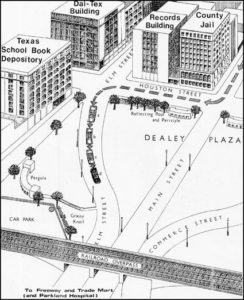 Author and researcher Brian Edwards joins S.T. Patrick to discuss Dealey Plaza as the site of a tactical operation, and then the witness testimony of Ed Hoffman. Edwards is singularly unique in discussing both topics. He was a former law enforcement officer and trainer, and he has over ten years of counter assault experience. When he looks at Dealey Plaza, he looks at it as more of a tactical operations site than a historical landmark. On this episode, he discusses Dealey Plaza as such a site. How would the perfect operation in Dealey be performed? What are the risks? How can the risks be overcome? How many personnel would be required? Where would the personnel be located? Edwards was also the co-author, with Casey Quinlan, of the book Beyond the Fence Line: The Eyewitness Account of Ed Hoffman and the Murder of President Kennedy.
Author and researcher Brian Edwards joins S.T. Patrick to discuss Dealey Plaza as the site of a tactical operation, and then the witness testimony of Ed Hoffman. Edwards is singularly unique in discussing both topics. He was a former law enforcement officer and trainer, and he has over ten years of counter assault experience. When he looks at Dealey Plaza, he looks at it as more of a tactical operations site than a historical landmark. On this episode, he discusses Dealey Plaza as such a site. How would the perfect operation in Dealey be performed? What are the risks? How can the risks be overcome? How many personnel would be required? Where would the personnel be located? Edwards was also the co-author, with Casey Quinlan, of the book Beyond the Fence Line: The Eyewitness Account of Ed Hoffman and the Murder of President Kennedy.
Brian Edwards is the co-founder of Project JFK.
Podcast: Play in new window | Download
Confusing: Edwards first states the logical position to shoot from one of the book depository is when the motorcade is on Houston Street coming toward the shooter. Later he says he thinks shooters were in buildings shooting when the motorcade is on Elm.
Then he says that he is convinced the bang and smoke witnesses saw behind the picket fence was a flash-bang diversionary explosive device. He then states that he thinks Ed Hoffman’s story of seeing the gunman fire from behind the fence is completely convincing. Anyone else confused or is it just me?
He thinks that the shooter in the Depository (observed before and during the shooting) was a distraction. The actual shooters were in other buildings. Perhaps, but by having a shooter being seen during the shooting, why take all the risk of being caught without getting any benefit of a shot? Why not just let him be seen before the shooting, leave the scene with the impression that a rifleman was spotted at that position?
If I understand correctly, he is saying that the diversion was staged at the east side of the fence whereas Ed Hoffman observed the actual shooting team at the west side of the fence. However, if Ed Hoffman was able to see this, then the “C” of concealment was obviously violated.
I think a shot from the knoll would have been risky because there was not good concealment and if the shot missed or hit Jackie or a bystander, it would have been hard to make the case for a lone nut. On the other hand, the head snap and the observations of the Parkland doctors supports such a shot.
I’m not sure Umbrella Man would have been visible from behind the fence or even the depository. A better position for a signalman might have been the infield and rather than an unusual umbrella a brightly colored article of clothing or a pro/anti JFK sign would have been less suspicious. I would not be surprised if Umbrella Man was covertly filming the assassination.
I suspect Oswald was a WILLING patsy who had been assured that there was easily debunked evidence being created such that he would have sufficient alibis to escape conviction and be a cause celeb for the Left and be perfect for future assignments. He would serve to focus attention on a single assassin and have sufficient confidence that he would not crack under interrogation. After all, didn’t he slit his wrists in a suicide attempt to get the Soviets to allow him to stay in the USSR? However, his handlers had other ideas.
John,
Kevin’s reply was a good one in describing the possible reasons to have people in the TSBD. There may have been shooters in the west 6th floor window. Also, Brian describes the TSBD being used as a place to spot. An op like this one needs someone high up in one of the floors or on the roof of one of the buildings in the plaza to be in control of when to fire. Perhaps that was some of your confusion as well.
Brian makes excellent points as to why we need to take Ed Hoffman’s story into account when trying to understand the whole of what happened that day. As he said, and others have echoed, Ed Hoffman was a credible, reliable witness.
Of all the things one can say about Oswald, “willing patsy” is not one of them. I suggest you look at his face during the police station “parades” of him when he finds out he has been accused of JFK’s murder. His face says it all.